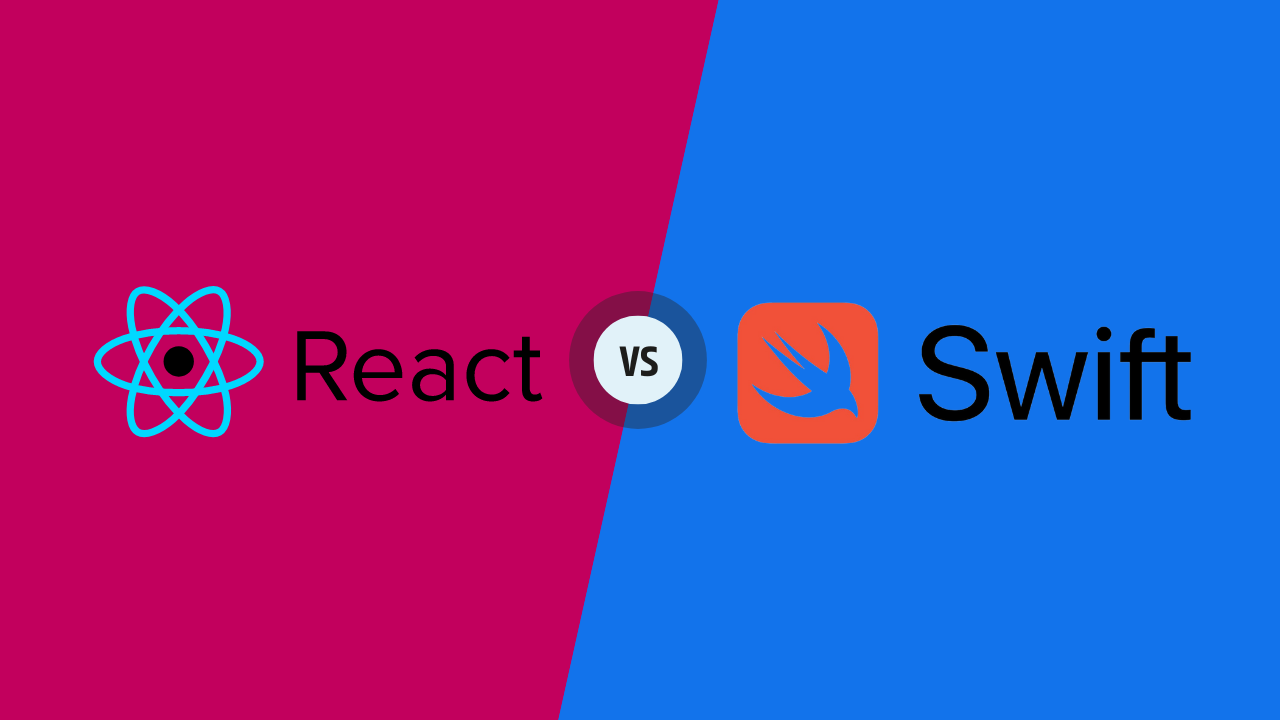Do you want to end your dilemmas of React Native vs Swift for your mobile app development? You are at the right place.
The main difference between React Native vs Swift – React Native is a JavaScript framework for building mobile apps that can run on both iOS and Android. Swift is a programming language developed by Apple for building apps for iOS, macOS, watchOS and tvOS.
Let’s see how to use the two technologies to empower your iOS app development journey.
React Native vs Swift: What are they?
As described in the introduction – React Native is a JavaScript framework for building cross-platform mobile apps for Android and iOS. Swift is a programming language developed by Apple for building apps for iOS, macOS, watchOS and tvOS apps.
React Native vs Swift: Detailed Comparison
Consider multiple factors while comparing React Native vs Swift for iOS app development. One major difference is their suitability for different types of development. React Native is well-suited for cross-platform development, allowing developers to create apps for multiple platforms using a single codebase. On the other hand, Swift is optimized for developing native iOS applications and offers access to the full range of iOS platform capabilities.
Consider factors such as performance, user interface, developer cost, and stability when assessing the best technology for your iOS app development. By evaluating these parameters and consulting with the right partner and developers, you can decide whether to use React Native or Swift for your project.
Related Post: React vs. React Native: All The Key Differences Explained.
React Native vs Swift: Speed
In terms of speed, React Native vs Swift are both highly performant options for mobile app development. However, they have different strengths and weaknesses when it comes to speed.
React Native utilizes a JavaScript bridge to communicate with the native components of the app, which can sometimes result in slower performance. However, mitigate this by using native modules and minimizing the number of calls made across the bridge. Additionally, the use of virtual DOM in React Native allows for efficient updates to the user interface, which can result in faster rendering.
On the other hand, Swift is a native language and has direct access to the iOS and macOS SDKs, which can result in faster performance. Swift also uses a static type system, which can reduce the number of runtime errors and improve performance. Swift code also tends to be more memory efficient than equivalent Objective-C code, as Swift automatically manages memory.
React Native vs Swift: Performance
The performance of React Native vs Swift applications varies depending on various factors such as GPU speed, CPU consumption, and memory usage.
In terms of performance tests, React Native has better memory usage and GPU speed compared to Swift. However, Swift has better CPU consumption. React Native allows developers to incorporate native code easily into the applications and offers various tools to assist with tasks.
In conclusion, when considering performance, React Native has an edge over Swift.
React Native vs Swift: User Interface
When developing iOS apps, Swift allows developers to create visually appealing and user-friendly interfaces easily. The Swift UI allows developers to create a native and optimal user experience.
On the other hand, React Native utilizes JavaScript libraries to build user interfaces. This approach allows developers to create platform-specific versions of components for a native-like experience. By utilizing JavaScript and declarative UI, React components can wrap up native code and communicate with native APIs.
In conclusion, both React Native vs Swift offers powerful tools for creating user interfaces. Swift allows for the easy creation of visually appealing and native-like interfaces, while React Native offers the flexibility of JavaScript libraries and declarative UI.
React Native vs Swift: Stability
When comparing stability between React Native vs Swift, Swift has an advantage due to its ability to fully utilize the capabilities of the iOS platform to build native applications. Swift handles heavy tasks, and visual effects and contributes to increased stability for the iOS platform.
While React Native is a popular choice for cross-platform development, it may not be the optimal choice for creating fully native applications. React Native primarily utilizes internal APIs and libraries to execute applications smoothly. However, this approach can result in multiple layers in the development process, potentially leading to decreased stability.
In conclusion, Swift offers more stability than React Native, when creating native iOS applications. However, React Native can be a suitable solution for cross-platform development.
React Native vs Swift: Developer Cost
When it comes to the cost of developing an iOS application, it can be more cost-effective to hire developers who are proficient in React Native. React Native developers are readily available and less expensive to hire than skilled swift developers.
Additionally, when building a team of developers, it may be more cost-effective to hire a team that is proficient in React Native, as it can be more challenging to find a team with expertise in both React Native vs Swift.
An important note is that React Native does not compromise the quality of the project. It is an effective and cost-efficient solution for organizations in the long term.
React Native vs Swift: Advantages for iOS App Development
The cross-platform compatibility and code reusability of React Native makes it an ideal choice for those looking to target both iOS and Android platforms with a single codebase.
Direct access to native SDKs, static type systems, and memory management of Swift make it an ideal choice for those looking to build high-performance iOS apps.
Let’s see why both of them are good for iOS development.
React Native
- Cross-platform compatibility: Develop apps for iOS and Android simultaneously and save time and money.
- Code reusability: Share a significant amount of code between the iOS and Android versions of the app.
- Virtual DOM: React Native utilizes a virtual DOM, which allows for efficient updates to the user interface, resulting in faster rendering.
- Familiar paradigm: React Native uses a familiar paradigm, similar to React, making it easier for developers already familiar with React to transition to React Native.
- Large community: It has a large and active community with access to a wealth of resources and support.
Swift
- Performance: Swift is designed to be safe and fast, with a static type system which helps to reduce the number of runtime errors and improves performance.
- Direct access to native SDKs: It has direct access to the iOS and macOS SDKs, which can result in faster performance for certain types of apps.
- Memory Management: Swift automatically manages memory, which can make the app more memory efficient than equivalent Objective-C code.
- Modern programming patterns: Swift provides modern programming patterns, such as closure and optional, which make it a very powerful language.
- Apple’s official language: Swift is Apple’s official language for building iOS, macOS, watchOS, and tvOS apps. This means that it has full support from Apple and is in line with the latest iOS features and guidelines.
React Native vs Swift: Uses
React Native uses native components. It makes the app feel like a native rather than a web app running inside a web view. This result in better performance and improved user experience. It also allows developers to share a significant amount of code between iOS and Android, saving time and money.
Swift is known for its performance, safety, and interactive development experience. It’s easy to read and write, fast and intended to be safe. Swift is a static-typed language so the data types are known at the compile time allowing for fewer errors. Swift also provides modern programming patterns, such as closure and optional making it a very powerful language.
Here are 10 companies that use React Native and Swift:
- Facebook: Facebook uses React Native to build the mobile versions of their app for both iOS and Android.
- Airbnb: Airbnb uses React Native to build their mobile app for both iOS and Android.
- Uber: Uber uses React Native to build their mobile app for both iOS and Android.
- Instagram: Instagram uses React Native to build the mobile versions of their app for both iOS and Android.
- LinkedIn: LinkedIn uses React Native to build their mobile app for both iOS and Android.
- Apple: Swift programming language is the primary choice of apple developers to develop iOS, macOS, watchOS and tvOS apps.
- IBM: IBM uses Swift to build their mobile app for iOS.
- Slack: Slack uses Swift to build its mobile app for iOS.
- SoundCloud: SoundCloud uses Swift to build its mobile app for iOS.
- Khan Academy: Khan Academy uses Swift to build their mobile app for iOS.
Conclusion
In conclusion, the choice between React Native and Swift ultimately depends on the specific needs and requirements of your iOS application development project. If you are looking to develop a cross-platform application, React Native may be the best option due to its ability to build apps for multiple platforms with a single codebase. On the other hand, if your project requires extensive use of native platform capabilities, Swift may be the more suitable choice.
Ultimately, it is important to evaluate your project’s unique needs and consult with experienced developers to determine the best course of action. Or you can contact us with your needs and we will deliver your project within your scheduled time.
React Native vs Swift: FAQ
Which one is better for iOS app development, React Native or Swift?
The choice between React Native and Swift for iOS app development depends on the specific needs of the project. If you’re looking to build a cross-platform app, React Native may be a better option. On the other hand, if you’re looking to build a fully native iOS app, Swift may be the better choice.
Can I use React Native to build apps for both iOS and Android?
Yes, React Native can be used to build apps for both iOS and Android. It allows developers to write code once and deploy it to multiple platforms, which can save time and resources.
Is Swift faster than React Native?
The performance of React Native vs Swift depends on multiple factors such as GPU speed, CPU consumption, memory usage, and many more. In general, Swift has been observed to have better CPU consumption, while React Native has been observed to have better memory usage and GPU speed.
Can I use React Native to create visually appealing and user-friendly interfaces?
React Native utilizes JavaScript libraries to build user interfaces, which allows developers to create platform-specific versions of components for a native-like experience. However, Swift offers the ability to create visually appealing and native-like interfaces with ease using SwiftUI.
Will using React Native make my app less stable?
React Native, while being a popular choice for cross-platform development, may not be the optimal choice for creating fully native applications. React Native primarily focuses on utilizing internal APIs and libraries to execute applications smoothly. However, this approach can result in multiple layers in the development process, potentially leading to decreased stability.





